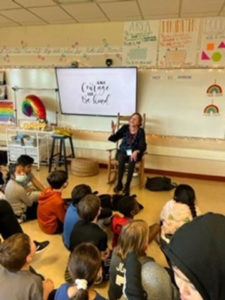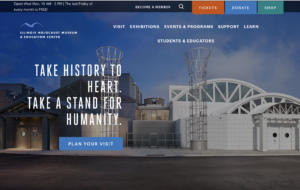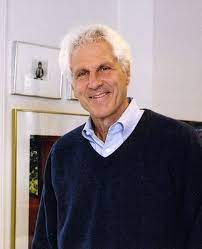On September 28 last year, Beth and I were in Lake Geneva, Wisconsin, thanks to the generosity of her nephew Ben—who owns a sweet little condo right off the lake, and who let us take a break from downtown Chicago.
We got a call – our friend Brad had died after having seemingly survived lung cancer, only to have it roar back in multiple forms. Beth and I were scheduled to stay another night in Wisconsin, but after a very brief talk, we decided to head home to be with our friends, friends who had rallied around Brad to the very end. It was really no decision at all so much as a need.
I’d been working at my laptop at the breakfast bar, and when I stood from the stool to start packing to leave, I was frozen in excruciating pain. My lower right back and hip just radiated misery, and I couldn’t bear weight on my right leg. I remembered that the condo had a jacuzzi—Beth started the hot water and I more or less crawled to the tub. She found the switch for the jets, and I got in and curled up so that they fired on my back and hip.
It worked—I managed to get in the rental car and get us home, and we met our friends at the local watering hole where we’d hung out with Brad. It was therapeutic.
My back remained irksome—and I lost feeling in a couple toes and my foot flopped, so I saw my Dr. I had an MRI and got a call with the results—I had a herniated disc that was pushing on nerves. These nerves, the Dr. explained, controlled my leg, as well as my bodily functions, so I’d best see the spinal surgeon ASAP. Two weeks later, Beth and I sat in the specialist’s office. He showed me the images of my spine and my hoodlum disc. After some conversation, we decided I’d try physical therapy and then come back.
After two weeks, I was still limping, but my foot and leg were measurably stronger, so we stayed the course with PT and no surgery. It was a slog. I was restricted from lifting or any physical vigor. In our household, that required a lot of creativity. Beth has always been able to take the garbage to the chute just down the hall. But recycling requires navigating to the bins in our loading dock. Where there is recycling, there is a way. We got the communal cart that we typically use for groceries and big packages. Beth loaded the recycling bag, and I pulled the cart with Beth in tow. I guided us to the recycling bins, and Beth lifted and emptied the bags.
And so it went. I had groceries delivered and transferred them from a table in the lobby of our building to the cart by more or less tipping the bags over onto the cart. I unpacked the lightweight stuff and Beth took care of the rest.
Come Thanksgiving we ordered a fresh local turkey from our little market down the street. When it came in Beth brought her big backpack and I guided her and our turkey home. Beth put it in the fridge and when it came time to dry brine it, she lifted it out of the fridge and put it on the counter. When I was done, she returned it to the fridge.
On Thanksgiving day, she lifted it into the roasting pan. Together, we lowered the roasting pan into the oven—she grabbed one handle, I grabbed the other and I guided us onto the baking rack.
That’s also how we took it out—teamwork—and for the record, the turkey was fantastic (not dry) and also yielded some great broth.
And that’s how it was for several months. Together we applied the same kind of creativity that Beth and I had to find when she lost her sight nearly 40 years ago, the kind of ingenuity that Beth has to employ to navigate her life to this day.
On December 23 (Beth’s birthday and Festivus!) I had a routine skin check. I’ve had some pre-cancerous stuff removed in the past, so these checks have become a regular ritual. My regular dermatologist was on leave so I saw a different doc. She introduced herself and said, “Word on the street is you have a lot of moles.” Not exactly the reputation I’d cultivate but she wasn’t wrong.
Two spots were suspicious, and both were biopsied and I got stitched up and went home. A week later the results indicated one of the two areas was a real problem. The good news is it was caught early, the bad news is it sits in an awful spot—just above the knee on the inside of my thigh, where things bend.
I’ll save you the gory details save to say—they’re gory. I have a gazillion stitches that bark at me every time I move. They’re coming out Friday but it’ll be awhile before I can do stuff like exercise. This after finally being cleared for the treadmill after months of PT for my back.
And just to top things off, on Saturday, I was making room in the refrigerator to store a big old pot of sloppy Joe’s that I’d made for a neighborhood get-together Saturday night.
As I pushed stuff back on the left side of the shelf, a giant jar of pickles squirted out the right side and landed squarely on my barefoot right big toe. I screamed. Beth ran out of her office to find out what was wrong. I cursed. I iced.
I returned to our chaise lounge, which has been my nest for the past several week. Leg extended, ice pack on my stitches, and now, frozen peas on my toe. A thoroughly inglorious existence.
At this point I was pretty sure I’d skip the party and send the sloppy Joes with Beth and stay on the chaise where I could do no more harm. One of our friends, Steven, offered to drive me the two blocks and promised to take me back home whenever I needed to go.
Ultimately, I donned my sweats, and slippers (regular shoes were too painful for the toe) and Steven brought me door-to-door. I hobbled to a couch, our party host Ruth brought me an ice pad, and I roosted.
Our friend Jim brought me food, our friend Laura brought me beverages, and I had a great time, much better that I would’ve had moping on the chaise.
That very morning our friend Colleen had delivered a care package that included her world famous minestrone (along with some grated parmesan), frozen pesto, and fancy dried pasta. Beth had engineered her visit, which was a surprise, and I about cried. OK maybe I did a cry little bit.
I’ve had some very painful and low-spirited times in the past few weeks. Ultimately, they’ve left me humbled and more grateful for life than I’ve ever been.
I’m lucky because I have good health insurance. It would’ve been easy to avoid that skin check, and if I weren’t insured, there’s no doubt I would’ve skipped it or put it off. And that probably would’ve been it for me.
I’ve got kind, sharp-witted friends who are steps away, and who made me completely forget my stitches and my toe Saturday night.
And best of all, I have a beautiful and intrepid partner who can help me get a turkey in and out of the oven. What else do you need?


